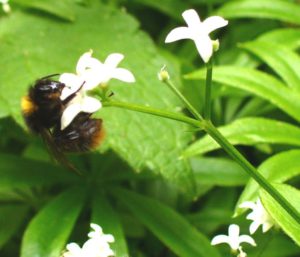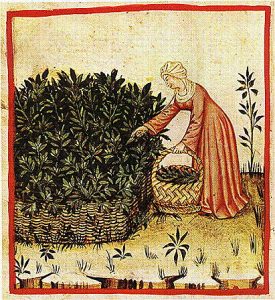SWEET WOODRUFF (Galium odoratum)
Europe
Sweet Woodruff is a hardy woodland plant, a shade-loving perennial that forms a carpeting mat.
Whorls of dark green lance shaped leaves are the backdrop for tiny WHITE starry flowers that appear in May, smelling of honey & vanilla. They bloom until July.
BEES FAVOURITE
Bees and flies pollinate the flowers.
Often grown as a low maintenance ground cover in shady areas or under trees. Galium Odoratum can look lush in a woodland garden, or near plants able to withstand its dense growth.
As slugs & snails do not fancy it, those perfect leaves are never shot with holes. Unwanted plantlets can easily be pulled up in spring & planted elsewhere.
Sweet Woodruff may turn crisp in dry, heatwave summers, shift into dormancy and die back to the ground.
A Medieval Strewing Herb
Strewing herbs were used to mask unpleasant smells & provide pest control in the Middle Ages. Reeds, rushes & straw were laid on floors of houses, from the palaces of the gentry to the dirt floors of peasant’s cottages.
Fragrant & astringent herbs were scattered – strewn – over the rushes straightaway, with more added over time. These herbs released a sweet smell when walked on, disguising any pongs that might have built up in the rush matting… crumbs of mouldering food, animal dander, mud etc. Certain herbs also acted as deterrents to snakes, rats, fleas & other pests.
Strewing herbs included mint, lavender, meadowsweet, rosemary, thyme, rose petals – & Sweet Woodruff, used as a strewing herb from at least 1300 onwards. The intensity of Galium odoratum’s fragrance increases when dried. The entire plant smells of new-mown hay & retains its aroma for years.
‘Imagine the scene: you have traveled all day on foot or by horse. It is centuries before hotels, but you know you will be lodging with the local baron. You arrive at dusk, share a rowdy, highly seasoned meal in the torch-lit main hall, and get ready for sleep. The preparations are simple: the trestle eating tables are broken down and stacked against the walls. You elbow your way to a position near the central fire, make a pillow of your baggage, wrap yourself in your cloak, and stretch out on the hard floor, which is thickly strewn with rushes. You share the hall with all the other guests, much of the baron’s household and family, and the household dogs…’ Robbie Cranch, Mother Earth Living
https://www.motherearthliving.com/gardening/strewing-herbs-zmaz91djzgoe/
Wikipedia has a list of strewing herbs. https://en.wikipedia.org/wiki/Strewing_herb
Strewing Herbs – The Age of the Great Unwashed! Kali S. Winters, Pioneer Thinking, Mozilla Firefox
Medieval Herbalism : Intro to European Herbalism, Candace Hunter, author of Herbalism for the Zombie Apocalypse.
Sweet Woodruff’s scent often described as freshly mown hay & vanilla – made it a favourite choice for nosegays. It is said that Queen Elizabeth I would hand dried Woodruff posies to anyone on whom she wished to bestow temporary favour.
The post of Royal Herb Strewer was created in 1660 by King Charles II.
Herbal strewing continued until the eighteenth century.
The Foraging Course Company, https://www.foragingcoursecompany.co.uk/post/articles-sweet-woodruff-folklore-and-history
Herbal and Traditional
:Medieval soldiers believed the flower could guarantee success on the battlefield, so they packed it into their helmets before engaging the enemy. For some Christians, the plant honors Mary, as traditional belief holds that sweet woodruff lined Christ’s manger. https://www.petalrepublic.com/sweet-woodruff-flowers/
‘ The flower’s sweet smell is due to the presence of coumarin… used mainly in Germany to flavour May wine… as syrup for beer (Berliner Weisse), ice cream, and medicinally as a herbal tea with gentle sedative properties… but beware, high doses can cause headaches, due to the toxicity of coumarin.’
Sweet Woodruff has had many uses over time. Powdered leaves were put into potpourri & mixed with snuff; in the Middle Ages its fresh leaves, bruised & applied to cuts and wounds, were said to have a healing effect.
The plant when newly gathered has but little odour, but when dried, has a most refreshing scent of new-mown hay, which is retained for years.
Gerard tells us: ‘The flowers are of a very sweet smell as is the rest of the herb, which, being made up into garlands or bundles, and hanged up in houses in the heat of summer, doth very well attemper the air, cool and make fresh the place, to the delight and comfort of such as are therein.’
 In Germany, one of the favourite hockcups is still made by steeping the fresh sprigs in Rhine wine. This forms a specially delightful drink, known as Maibowle, and drunk on the first of May.
In Germany, one of the favourite hockcups is still made by steeping the fresh sprigs in Rhine wine. This forms a specially delightful drink, known as Maibowle, and drunk on the first of May.
The dried herb may be kept among linen, like lavender, to preserve it from insects. In the Middle Ages it used to be hung and strewed in churches, and on St. Barnabas Day and on St. Peter’s, bunches of box, Woodruff, lavender and roses found a place there. It was also used for stuffing beds.’
Maud Grieve, A Modern Herbal 1931 / written to cope with medicinal needs of the First World War.
https://www.botanical.com/botanical/mgmh/w/wooswe31.html

A Tiggy stretch in sunshine at opposite end of garden from the Sweet Woodruff, which was not in the sun. September 6 2006.
Sweet Woodruff at Highbury
When the sun shone on it, our garden cat Tiggy would throw himself, paws outstretched, onto a cushion of Sweet Woodruff for a fragrant nap.
Other names: Asperule, Asperula odorata, Bedstraw, Galii Odorati Herba, Hay Plant, Herb Walter, Kiss Me Quick, Ladies in the Hay, Lady’s Needlework, Madder, Master of the Wood, Mugwet, Muge-de-boys, Musc de bois (Old French, ‘Musk of the Woods’), Our Lady’s Bedstraw, Our Lady’s Lace, Petit Muguet, Quinsywort, Reine des Bois, Rockweed, Sweet Grass, Sweet-scented Bedstraw, The Suisse, Waldmeister (German, ‘Master of the Forest’), Wild Baby’s Breath, Wood Rove (13th C. Old English, ‘Wuderove’), Woodrow.













